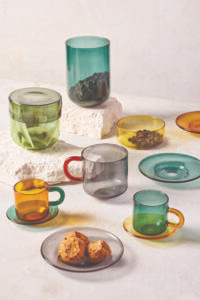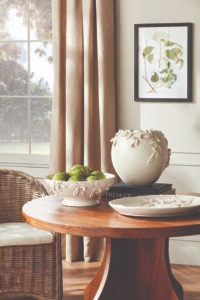Joy, Comfort and Sustainability Driving 2025 Home Décor Trends
2025.07.24
After years of making big purchases and investing in costly renovations, homeowners are shifting their spending priorities. While large-scale remodels took a step back, spending on home décor remained steady — and in some categories, even grew. According to the latest studies, homeowners are still investing in their spaces, but they are doing so with a more intentional focus on comfort, functionality and well-being.
So, what exactly are consumers putting their money toward at home? The data reveals a growing interest in smaller upgrades, décor that supports healthier living and seamless indoor-outdoor environments. As economic pressures persist and the desire to stay home continues to rise, people are rethinking what it means to feel truly at home and are prioritizing spaces that bring joy, promote wellness and reflect their personal values.
Tracking Spending
According to the latest U.S. Houzz & Home Study, homeowners invested less in remodeling projects in 2024 while home décor spending remained steady.
Among the 22,000 respondents, median spending on renovations fell to $20,000 among the 54 percent who took on a remodeling project in 2024. This was down about 17 percent from 2023’s $24,000 median amount.
The study also found that investment in smaller spaces saw growth, while major renovations such as large kitchens and large bathrooms held steady at a median cost of $55,000 and $25,000, respectively.
Home décor purchases remained stable in 2024, too. Large furniture purchases jumped by 4 percentage points to 41 percent, moving it up to third on the list of purchases from fifth the previous year. Topping the list of décor buys was rugs at 49 percent, followed by pillows and throws at 45 percent. Rounding out the top five was artwork at 41 percent and small furniture at 39 percent.
Millennials, who took on home decorating projects most frequently in 2024, were more likely to buy large interior furniture, with the share increasing to 48 percent from 44 percent previously. More than three-fourths of millennials redecorated last year, with Gen Xers second at 70 percent.
Notably, more than half of homeowners enhanced their outdoor space in 2024, completing two projects on average. Among the outdoor décor items purchased during remodels were lighting at 27 percent, large furniture at 23 percent, small furniture at 19 percent, pillows and throws at 16 percent, and rugs at 15 percent.
And those numbers track with the once again growing consumer affinity for integrating their indoor and outdoor spaces together.
In its 2025 Trends Outlook Report, the American Society of Interior Designers (ASID) highlighted the returning interest in outdoor spaces as part of a larger trend towards “creating environments that inspire joy, foster well-being, and harmonize sustainability.”
“The focus on well-being continues to inspire seamless connections between indoor and outdoor spaces,” said ASID. “Outdoor kitchens, dining areas, living areas and biophilic design features are fostering deeper connections with nature while promoting social engagement. Innovations in materials, such as textiles that combine outdoor durability with indoor aesthetics, are enhancing the functionality and appeal of these hybrid spaces.”

Designing Comfort
The disappearing boundary between indoor and outdoor works well with the growing trend of home wellness-focused design, which sees consumers’ emphasis on health and wellness more frequently impacting design decisions.
For some consumers, this focus on well-being will result in new kinds of spaces being built into their homes — think spa-like bathrooms, at-home yoga studios and meditation rooms — but for others, it will mean incorporating décor items into their daily life that reflect those healthy spaces. Products that bring the “spa vibe,” including indoor plants, décor items in calming colors, soft lighting and more, will be more popular, as will products that subtly promote spirituality.
Home décor that appeals to multiple senses — think of products that add rich textures, scents, sounds and lighting to a space — will continue to be important both for shoppers looking to create a healthy space and those looking to just double down on comfort in their home. As the outside world grows more turbulent and more expensive, consumers will continue to seek respite in their homes, and they will be looking to add products that make it easier and more comfortable to do so.
Joe Derochowski, a Circana home industry advisor, shared a similar message during a keynote session at the Inspired Home Show 2025, telling attendees that the housewares industry is poised for steady growth both in units and dollars through 2030 because “there’s no place like home.”
Derochowski dubbed the consumer trend of staying home “turtling,” noting that today’s inflationary environment is causing people to stay home more.
“It’s four times more expensive to go out and eat,” said David Portalatin, Circana senior vice president andindustry advisor for food and foodservice. He said people desire easy solutions like heat and eat, or opening a bag or box to get to a quick meal — a snackification of sorts throughout the day. Similarly, people are seeking home products that offer the same ease of use.
People are also turtling by entertaining at home more, finding escape in fiction books and turning to nostalgic video games, according to the Circana experts. Soft blankets, pillows, comfortable seating and multipurpose items — think tableware that can be used for everyday meals and for hosting — will all be part of that rise.

Feeling Green
Customers have said that sustainability matters to them for years, and in 2025, it is becoming even more important for customers looking to curate clean, healthy and comfortable homes. According to respondents who participated in the 2025 Gift Book Consumer Survey, 52 percent said that a product being sustainable/eco-friendly was somewhat or very important to them, and 64 percent of those respondents said they would be willing to pay more for those products.
But what green products and movements are they interested in aligning their spending with? After years of discussion and education on the topic, consumers have wised up to many of the greenwashing practices that permeate the industry today, so they will be doing their due diligence and seeking out more authentic products and stories before spending on supposedly sustainable and eco-friendly brands and products.
Green home décor is defined by its materials. Sustainable, natural materials like bamboo, cork, coconut, straw, cob, and natural fabrics like hemp, wool, cotton and jute will be more popular because of their renewability and natural origins. Real woods and stones will be less popular in this category because they are perceived as less renewable and/or recyclable. Repurposed objects — such as cardboard and paper, bottles, license plates, fabric scraps, discarded books, and deadstock wallpaper and fabric — will also make a big impact in the space.
Carrying products made with recycled metals, plastics and other material that has to be processed for reuse will also continue to be popular, but keep in mind that many consumers are opting to go plastic-free whenever they can. This is especially true for products related to food preparation and serving due to concerns about pollution and health concerns about exposure to and consumption of microplastics. According to a 2024 World Wildlife Foundation survey, the vast majority of Americans (85 percent) think that plastic waste pollution is a serious and concerning problem that needs to be addressed immediately.
Before carrying any eco-friendly products and brands, retailers should invest time into researching them just like their customers. Terms like green, eco-friendly, all-natural, earth-friendly, plant derived, organic — but not organic certified — and non-toxic can be used by manufacturers without meeting any legally required testing or standards.
Retailers should look for third party certifications — examples include Fair Trade certified, Environmental Working Group Verified, B-Corp, Made Safe and Cradle to Cradle certifications — to be sure they are picking vetted products that meet industry standards for those labels. Transparency also goes a long way when vetting new products and brands, so seek out brands that are willing to share their sustainability goals, production processes, and waste and recycling statistics.

Seeking Joy
For consumers, caring for their well-being goes beyond just their physical health needs — people are looking to promote their mental health, too. According to Derochowski, there is a greater desire for more joy in all aspects of a consumer’s life — from decorating to entertaining to eating to beauty to organizing. People may treat themselves with purchases when they are feeling good, but also when they are not, to feel better.
Enter dopamine décor, a home styling offshoot of the TikTok-famous “dopamine dressing” trend which encouraged participants to wear clothes that make them feel good regardless of trends or “fashionability.” This trend encourages people to decorate their homes with personal pleasure in mind over set aesthetics or styles. Dopamine décor is all about promoting your brain’s reward system and tapping into — both literally and figuratively — your body’s store of dopamine, or the neurotransmitter that acts on areas of the brain to give you feelings of pleasure, satisfaction and motivation.
And while your customers may not identify with dopamine décor in its traditional definitions — think color drenching walls with bright colors, pattern mixing textiles and loading a room up with accessories — they are aligning themselves with other feel-good trends, like the rise of mixing styles, cultures and time periods. Consumers, according to designers and trend experts, are less attached to set styles and more willing to mix new and old pieces in pursuit of quality, uniqueness and nostalgia.
“Timeless craftsmanship and nostalgia are making a comeback, with designers incorporating historical elements, vintage furnishings and handcrafted details into modern spaces,” said ASID in its 2025 Trends Outlook Report. “The blending of styles reflects a growing consumer demand for sustainable, long-lasting designs that tell unique stories.”
In today’s fast-paced world, the home has become more than a place to live — it is a place to feel good. As consumers’ budgets tighten and their spending becomes more intentional, their focus is clear. They want to create spaces that spark joy, support well-being and reflect who they truly are. Whether it is through sustainable materials, cozy spaces, vibrant colors or thoughtful outdoor integration, people are turning to home décor as a source of comfort and happiness. The rise of feel-good trends like dopamine décor, mixed-era styling and wellness-inspired design shows that joy is no longer a luxury at home — it is a necessity.

















 Visitor Registration
Visitor Registration Booth Application
Booth Application